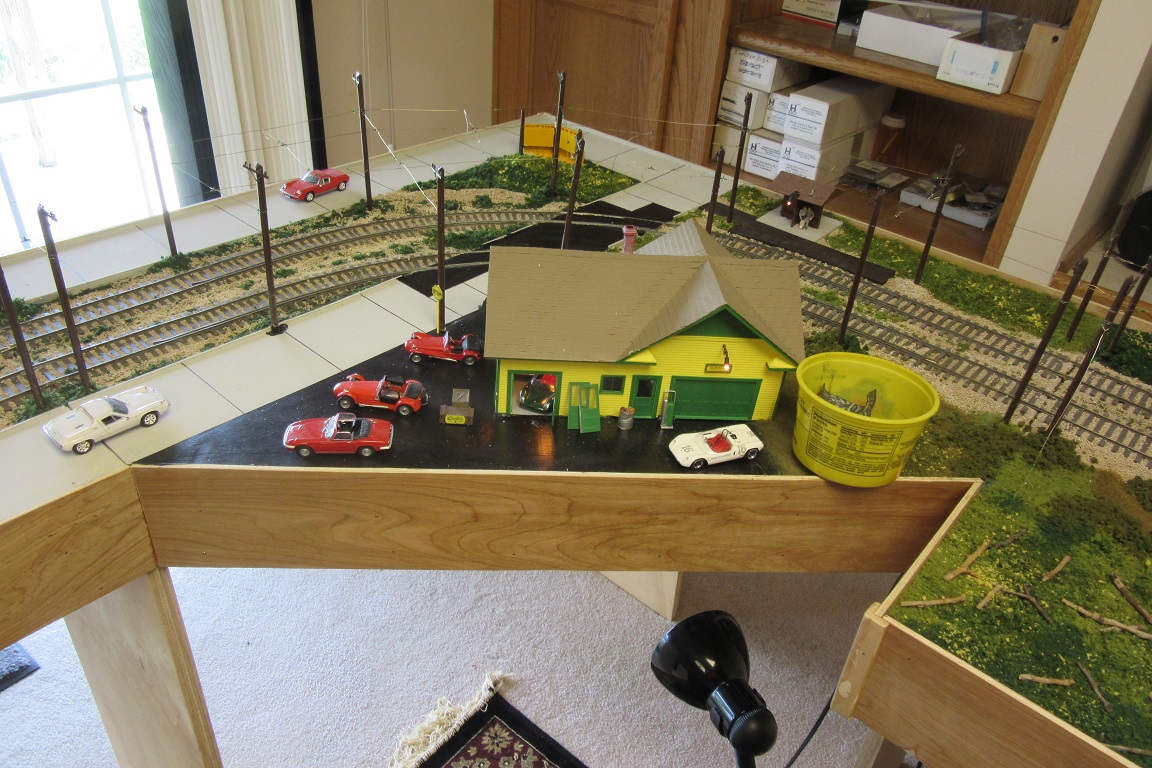 The East Penn Traction Club
The East Penn Traction Club
Member Layout Photo Gallery
Ed Halstead's Chicago & Utopia Railway
The Chicago & Utopia Ry. (C&URy) was started in 2015. We had moved into a
3-story townhouse with the bottom floor being a finished basement. The largest floor space in the
basement allowed the building of a 10-module trolley layout roughly based upon EPTC O Scale
Module Standards. The modules followed the space standards but not the electrical.
The track plan is based on the La Grange line of Chicago & West Towns Railway (CWT). To
find out more about the CWT maps, photos, and information can be found on the internet or the
Central Electric Railfans' Association (CERA) Bulletin 138 "The Chicago & West Towns Railways."
All trolley operations of CWT had ceased operation on April 10, 1948 and a new owner, me,
purchased the La Grange Line, shops, and rolling stock. The new La Grange Line is called the
Chicago & Utopia Ry. Rail operations started immediately.
Utopia as a name was chosen for what the word "utopia" means. Utopia was the name of a small
town about 3 miles north of my townhouse. Utopia allowed me to operate trolleys from various
street railways and interurbans besides the CWT cars.
Some general comments about the modules - both modules with 90 degree curves are 18" radius curves mainly for freight cars. The freight cars will not operate around the 14" loops. All turnbacks were built using R-O-W street turnout castings both in the street trackage and the open track. Operation of the layout is one-man. But each return loop can be controlled by a hidden off-on switch. This allows for 2 cars to be run at one time. The faster car can be stopped in the loop while the slower car can move ahead.
To fully built the CWT La Grange Line at least an additional 10 modules would have to be built to capture other outstanding features of the Line. However, space would not allow me. The room the layout is in has a sliding door leading to a patio and the great outdoors. My wife would not allow me to built more modules!
(Click on the thumbnails to see a larger image)
 | Module #1 - East End of Line 22nd St & Cicero Ave. Intersection. An incomplete module to be worked on later. Originally the La Grange line was an end to end operation using only double end cars. A return loop had to be added for continuous operation. The Hawthorne Works of Western Electric was at the south east of the 22th St and Cicero Ave. intersection. |
 | Module #2 - Shops aka the Siberian Barn on Harlem Ave. An incomplete module to be worked on later. This module is out of place. This is caused by the configuration of the layout for the allowable space. This module should be a stub end piece attached to Module #4. |
 | Module #3 - 22nd St. An incomplete module with only a blue painted backdrop in place. Building fronts will be installed to give the impression of the various shops along 22nd st. |
 | Module #4 - Intersection of 22nd St. & Harlem Ave. An incomplete module to be worked on later. The single track leads to the correct location of Module 2 the Shops. CWT had removed part of the trackage at this intersection. to prevent problems with turning trolleys and those going to the barn. |
 | Module #5 - Harlem Ave. The right of way in Harlem Ave was built with open track work with lanes of traffic on both sides of the track. Harlem Ave. at this point was and still in a very wide street. |
 | Module #6 - Intersection of Harlem Ave & 26th St. Both of the modules #4 and #6 are 90 degree curves built on 36" x 36" modules to consume the least amount of space. When the CWT was in operation all of the land around the track was most;y empty lots. This turn was actually north of where 26th St. was located to make space for the Illinois Central RR. crossing and interchange which will be seen in the next module. |
 | Module #7 - Parkway Jct. Interchange with IC Railroad. This module is 24" wide to allow for space for the interchange track and crossing. At this point the Illinois Central was a 2-track right-of-way going west to Iowa. The CWT interchanged tank, insulated refrigerator, and box cars for the florist company north of the shops plus hoppers and box cars for the Shops. The CWT passenger cars used hard coal received in either the hoppers or in 5 lb bags in the box cars plus parts for the cars. |
 | Module #8 - Crossing 1st Ave. The CWT crossed the busy 1st Ave. at a grade crossing protected by 5 overhead flashing red bulbs and cross bucks. The C&U does the same with the use of a flagman to stop autos and trucks. |
 | Module #9 - South Entrance to Brookfield Zoo. This module is 24" wide to allow enough space for the Entrance building. The CWT had been built about 30+ years before the World famous Brookfield Zoo. The Zoo provided the majority of riders for the La Grange Line. During peak travel days to the Zoo, the CWT routinely turned-back cars to provide adequate service between 22nd St and Cicero Ave. and the Zoo. |
 | Module #10 - West End Zoo Loop. The C&U built the loop. The tracks continuing west go to the suburbs of Brookfield and the end of the Line at La Grange. Both of the modules with loops are 36" wide to provide for 14" loops. This allowed for the operation of almost all streetcar models and coupled-up interurbans in trains. |


